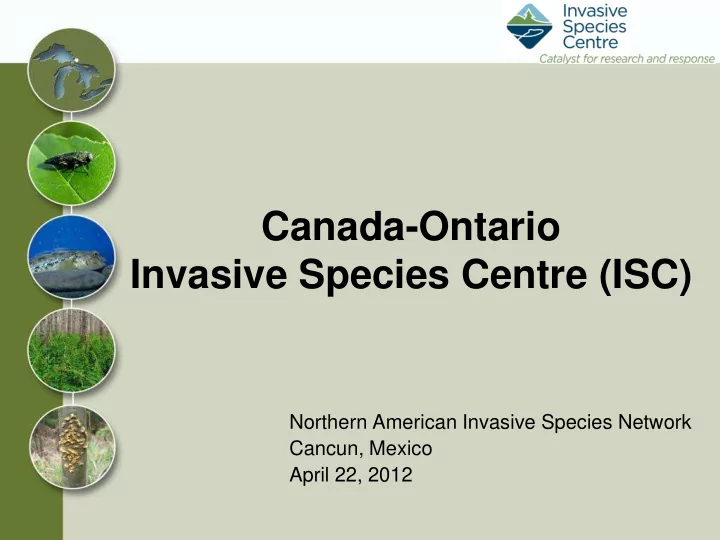

Canada-Ontario Invasive Species Centre (ISC) Northern American Invasive Species Network Cancun, Mexico April 22, 2012
Presentation Agenda • Context – Invasive Species in Canada with focus on province of Ontario • Background – Canada’s and Ontario’s collaborative response to invasive species (terrestrial and aquatic) • Overview of Canada-Ontario Invasive Species Centre (ISC) • Vision and Mission • Expected Outcomes of ISC • Recent Accomplishments • Future Directions for ISC • NAISN-ISC Collaboration Opportunities
Context • Province of Ontario is an epicenter for invasive species • Approximately 70% of containers arriving in Canada are opened in Ontario making the Province an epicenter for invasive species. • Toronto is hub for international travel and shipping. • Province has culturally diverse society. • Invasive species result in large economic losses in Canada. • Historical losses nationally from all known invasive species averaged $7.5 billion annually. • Projected (2015) annual losses range from $13.3 to $34.5 billion. • An estimate of the total direct cost of all invasive species programs in Ontario is not available. However, several program (annual) costs have been identified as follows: • Ontario Power Producers: $7.4M on zebra mussels; • Canadian Government: $8M on sea lamprey control; • City of Toronto: $7.4 million on emerald ash borer. • Ecological Impacts – Devastating; more difficult to quantify
Background • Emerald ash borer and Asian long-horned beetle outbreaks exemplified the need for better invasive species management coordination between Ontario and Canada. • Provincial and federal departments with an invasive species mandate developed a “Collaborative Framework Agreement” that outlined the purpose, scope and functions of an Invasive Species Center (ISC). • The ISC was incorporated as a Not-for-Profit entity in March 2011 (9-member Board of Directors). • The ISC Charge - Improving research and response coordination among provincial and federal governments, academia, municipal governments, First Nations and non- government organizations .
Expected Outcomes • Improved prevention of the introduction of invasive species • Improved early detection of and rapid response to the discovery of invasive species • Better coordination of natural and social scientific research efforts that support prevention, management and eradication efforts • Effective facilitation of communication, collaboration and technology transfer with industry, local governments and authorities • Improved co-ordination and efficiency of Partners and the public in addressing invasive species ISC Strategic Business Plan outcomes reflect priorities in the Government of Canada Invasive Alien Species Strategy (2004) and Ontario Invasive Species Strategic Plan (2011)
ISC Accomplishments, Nov. 2011 – Mar. 2012 • Sponsored over 60 research and special projects • scientific research ( i.e: enhanced monitoring/detection techniques; ecosystem impact determination metrics ) • policy, legislative, program delivery ( i.e: legislative gaps; outreach/communications program effectiveness ) • Developed Operational Plan for 2012/13 • Initiated development of ISC Governance Model • Formalizing committee and council structure to officially engage partners (Govt. Agencies; Academia; Industry; First Nations; Municipalities; Non-govt. Organizations • Thinking Internationally - ??? • Engaged in outreach to partners (limited to date) • Transitioned (ing) from “start-up” to Operations
ISC Future Direction Highlights from Operational Plan 2012/13 1. Develop formal Research Program, Science and Technology Transfer Program, Internship Program, and Outreach and Education Program 2. Enhance Website as Information Portal for “all things invasive species” 3. Institutionalize ISC Governance to formally engage full network of partners - including industry 4. Build ISC Brand and Diversify ISC funding (beyond Ontario Government) 5. Build coalitions - nationally and internationally
ISC Future Direction (continued) Building Coalitions – nationally and internationally Is NAISN one of those opportunities? 1.What can the Canada-Ontario Invasive Species Centre bring to NAISN? 2.How can NAISN help the Canada-Ontario Invasive Species Centre with its Strategic Outcomes? 3.What Governance is in place to facilitate coalitions? 4.What resources (financial and time) might be required to contribute to/benefit from a NAISN/Canada-Ontario Invasive Species Centre coalition?
Thank You Gracias
Recommend
More recommend